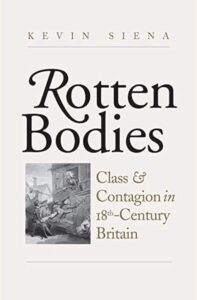 “Unclean! Unclean!”
“Unclean! Unclean!”
We all likely know the story – about how those with the leprosy, plague, or various other diseases were required to carry bells, clappers, or other instruments with which to draw attention to themselves, and shout “Unclean!” – thus warning any with whom they may happen to come into contact in the streets. It actually stems from a verse of the Hebrew Bible – Leviticus 13:45 to be specific, “And the leper in whom the plague is, his clothes shall be rent, and his head bare, and he shall put a covering upon his upper lip, and shall cry, Unclean, unclean.”
But what if the state of uncleanliness was not the result of a disease – what if it was an existential fact of a person’s life? What if certain people were not the victims of a disease but – as a result of simply existing – the organic source (not the vector, but the literal point of creation) for the disease? It’s a question Prof. Kevin Siena takes up in his new Rotten Bodies; Class and Contagion in Eighteenth-Century Britain.
As one who found Dr. Lindsey Fitzharris’ The Butchering Art absolutely captivating, and Prof. Melanie Kiechle‘s Smell Detectives; An Olfactory History of Nineteenth-Century Urban America extremely difficult to put down, I am very much looking forward to getting lost in the dank streets, filthy workhouses, and disease-ridden alleyways of 18th century Britain through the pages of this present work.
